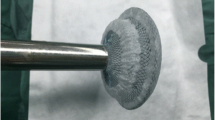Summary
The interventional occlusion of atrial septal defects still represents an experimental approach. As in all intracardiac implants able the double umbrella device (ASDOS®) is affected by late complications, particularly when involving umbrella thrombosis and umbrella dislocations. The demonstration of 4 case reports shows that late postinterventional complications can manifest in unspecific cardial and noncardial symptoms in patients with an ASDOS device. The diagnosis of a late complication was in all cases confirmed by transesophageal echocardiography and represents an indication for immediate surgical explantation. For early diagnosis and safe handling of late complications after ASDOS implantation the knowledge of the emergency physician about postinventional problems of this device is essential. Every ASDOS patient who is suspected of suffering from late postinterventional complications should undergo immediate transesophageal echocardiography. The emergency physician should get in touch with the implantation center immediately. Furthermore, the concept of interventional occlusion therapy of atrial septum defects needs further development to avoid late complications.
Zusammenfassung
Der interventionelle Verschluß von Vorhofseptumdefekten stellt eine experimentelle Therapieform dar. Wie bei allen intrakardialen Implantaten ist auch das Doppelschirmsystem ASDOS® (Atrial Septal Defect Occlusion System, geschütztes Warenzeichen der Dr Osypka GmbH, Grenzach-Wyhlen, Deutschland) von Spätkomplikationen betroffen. Die wichtigsten Spätkomplikationen nach ASDOS®-Implantation bestehen in Schirmthrombosierung und Schirmdislokation. Anhand von 4 Kasuistiken wird dargestellt, daß sich ASDOS-Spätkomplikationen bei den betroffenen Patienten initial in einer unspezifischen kardialen und/oder extrakardialen klinischen Symptomatik manifestieren können. Die Diagnose einer ASDOS-Spätkomplikation wird durch die transösophageale Echokardiographie gesichert. Nachgewiesene Schirmthrombosierungen und Schirmdislokationen stellen Indikationen zur sofortigen chirurgischen Explantation dar. Entscheidend für die frühzeitige Erkennung und das sichere Management von Spätkomplikationen nach ASDOS-Implantation ist das Wissen aller beteiligten Ärzte, bei diesen Patienten nicht eindeutig zuzuordnenden Beschwerden in die Differentialdiagnose auch eine postinterventionelle Spätkomplikation einzubeziehen. Jeder Verdacht auf eine postinterventionelle Spätkomplikation stellt bereits die Indikation zur sofortigen Durchführung einer transösophagealen Echokardiographie dar. Durch den erstversorgenden Notarzt sollte zudem sofort Kontakt zum Implantationszentrum aufgenommen werden. Das interventionelle Therapiekonzept zum Verschluß von Vorhofseptumdefekten bedarf weiterer Entwicklungen, insbesondere zur Vermeidung von Spätkomplikationen.
Similar content being viewed by others
Author information
Authors and Affiliations
Additional information
Eingegangen: 5 Mai 1997 Akzeptiert: 27. Mai 1997
Rights and permissions
About this article
Cite this article
Köhler, F., Gliech, V., Bohm, J. et al. Interventioneller Verschluß von Vorhofseptumdefekten mit dem System ASDOS Kasuistische Erfahrungen zu Diagnostik und Management von Spätkomplikationen. Intensivmed 34, 401–408 (1997). https://doi.org/10.1007/s003900050066
Issue Date:
DOI: https://doi.org/10.1007/s003900050066




